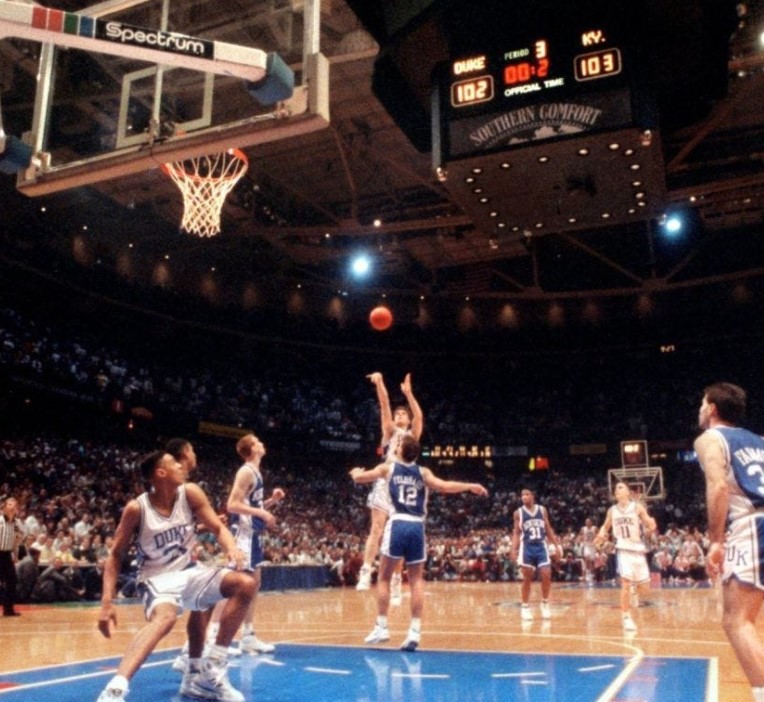This is another of those seminal weeks in the world of sports, as it is in the world of Canadian oil and gas. Let’s get the boring part out of the way first. As most Canadians know. Well Albertans know. OK, energy sector participants then. Ahem, as most of us industry people know, the end of March and first weeks of April are what’s known as Spring Breakup. No, it’s not the time of year when investors break up with the energy sector (although it often seems that way).
No, spring break up is that time of year when the upstream energy sector in Western Canada shuts down for all intents and purposes as various provincially mandated road bans come into effect, restricting movement of heavier vehicles and thus people in the middle of nowhere. In addition, as the snows begin to melt, the conditions on the ground for heavy machinery become difficult to operate in, with the impact getting worse the further north you travel where it isn’t uncommon actually lose pieces of equipment into the thawing ground. Remember the saying “in the winter Canadians drill”? There is a reason for that.
South of the border, this doesn’t happen the same way, although I suspect there is some small measure of a pause in places like the Dakotas as snow melts and rivers flood.
Where am I going with this? Well for Canadian industry participants, this is a time of year to sit back, relax, reflect and renew hope for the rest of the year with the 2021 drilling season for all intents and purposes behind us. Activity for the balance of the year may as well be part of 2022. Interestingly the next year looks great.
But it’s also a time of year where nothing really happens. It’s a really boring time of year. Traditionally. Last year wasn’t of course because of the pandemic and negative prices. But this year seems much more like prior years – it’s just there.
And nothing signifies the time of year and the leisurely approach to things than a round of golf, or four rounds. At the hallowed grounds of Augusta no less. The annual gathering of the world’s best, chasing a green polyester jacket so that they can claim to be a Masters Champion.
So I thought to myself it would be interesting to take a look at a Masters course, since we have so much leisure time, and see if we can’t figure out what a Masters Course might look like for the Canadian energy sector. Maybe we can even, along our leisurely and lazy journey, try and figure out who is most likely to come out on top as a true Master this year.
And unlike the actual Masters, we don’t have to worry about a serially incompetent driver missing the tournament, instead we get to indulge in a fantasy where everyone important actually shows up.
Taking my cue from Augusta, which awkwardly names each of its holes after a flower, plant, tree or shrub, I have elected to name each of my Master’s holes as well. Energy themed of course. Apologies in advance.
Hole 1 – Drilling Rig
Drilling Rig is the first hole on the course and is a par 4 totalling 445 yards. To do well on this hole you need nerves of steel because it’s the first hole (where I traditionally shank a ball into the closest semblance of water) so everyone is watching and if you miss your drive, there is a dry hole (bunker) waiting for you at about 300 yards. This type of hole is ideal for reasonably long hitters who have supreme confidence at being able to hit their spot – I’m thinking your typical upstream intermediate like Tourmaline.
Hole 2 – Offshore Capex
Offshore Capex is the first par 5 on the course and measures 575 yards. This hole is pretty straightforward but is navigated most successfully by the player who can take a chance and go long off the tee. Ironically with its marine theme, it is entirely possible to hit an albatross on this hole. Players like Diamond Drilling (when they get the clubs out of the pawn shop) and Chevron traditionally excel at this hole.
Hole 3 – Permian Party
Permian Party is a short par 4 which at 350 yards gives the players a risk and reward chance when playing this hole. First constructed in the early 20th century, the hole has been virtually the same ever since with the exception that the tee box has been moved to allow for a more horizontal approach where previously it was vertical. With a small and hidden green, players must make the decision early on whether to go for it or lay up. Either way, it’s a challenge. The most consistent player here is EOG, and may others have seen their corporate banking sponsorship pulled for inability to deliver.
Hole 4 – Oil Tanker
The first par 3 is a monster at 240 yards and if that wasn’t hard enough, it is also guarded by a pair of bunkers at the front of the green. There is nothing special about this hole or its name. Originally only about 180 yards in length, the hole keeps getting longer to emulate the length of the average oil tanker cruising around the world and the longest one that could ply the great lakes and canals from Thunder Bay through to Saint John. Plans are in place to extend this hole to 330 yards in 2022, but keep it a par 3. Players that do the best on this hole tend to be the trading houses, like Vitol.
Hole 5 – Alberta Election Prospects
Alberta Election Prospects and is a par 4 totalling over 500 yards and is strangely considered the hardest hole on the course. With a group of bunkers on the left side needing 315 yards to carry, you don’t want to go left here. Once on the green the contours funnel the ball to the hole. This hole requires a classic right-winger to navigate properly and taking a look at the cast of characters around, the most consistently right-leaner is Jason Kenney, so this hole is a natural for him, recording an eagle just a few years ago, although Rachel Notley famously holed out from one of the left bunkers in 2015.
Hole 6 – Orphan Well
Orphan Well is the second par 3 on the course and measures 180 yards. Most golfers can reach the green in one and it’s a birdie chance if players stay true to the course rules and play it straight. Any errant shot of course can lead to disaster as the rough is filled with abandoned wells left behind over decades and the front of the green is protected by a former tailings pond that has been recently filled with sand. As long as you can navigate the hazards, this hole can be rewarding and it is typically the major players that score the best here because everyone is paying attention to what they are doing.
Hole 7 – Crude by Rail
The hole that goes by the name of Crude by Rail has had the most change to it, including a green relocation, added bunkers, changed tee box and trees added all along the right of way that crosses the fairway. No one actually knows how long this hole is as it just seems to get longer and longer, especially at the series of level crossings. This hole has long been the favourite of none other than Warren Buffett, proving that sometimes the old guys are still able to dominate.
Hole 8 – Northern Gateway
Northern Gateway is the second par 5 on the course and measures 570 yards. The hole is very difficult to reach in two due to the new fairway bunker that was designed by local First Nations groups back in 2015. Strangely, this hole gets renamed every couple of years, having variously been called Energy East, Eagle Spirit and, strangely, Norther Gateway. This is a ridiculous hole no matter what it is called with the only people consistently scoring well on it being various media personalities and professional opinion makes who get paid to write about lost causes.
Hole 9 – Keystone
Keystone is the final hole on the front nine and is a 460 yard par 4. The toughest part of this hole is undoubtedly the approach shot; this is because this is the part of the course that crosses an international border and the course marshal, a cranky old guy named Biden, won’t actually allow anyone to do that, unless they are following the original layout of the course. For much of the past decade, proponents have been trying to put a new fairway in place but have so far been unsuccessful. The Canadian portion of the redesign was completed in 2020 at huge cost to the course landlord. TC Energy of course dominates this hole.
Hole 10 – Carbon Tax
Considered, along with the 5th, as the toughest hole on the course, Carbon Tax is a long par 4 totalling 495 yards. Originally a short pitch and putt hole, the green seems to get moved back every year and it is expected that by 2030 another 170 yards will be added. Every player who plays this hole is able to take 1 or 2 strokes off their score and apply it to a chosen round. As a result, it’s hard to tell if anyone is actually any good at this hole, but there has been way less crying since the rule change. Last year, a single mom from Calgary won a cheque for close to $900 for hitting an actual birdie.
Hole 11 – Energy Transition
This is the opening hole of Oh Crap Corner, where golfers are forced to suddenly reckon with their scores and realize they have limited time to close the gap on their competitors, especially on Championship Sunday. Energy Transition is a brilliant challenge due to it being a par 4 measuring a ridiculous 505 yards. Smart golfers will fade off the tee to avoid the exposed oilsands mine on the left. Successfully navigating this shot puts the green very much in play. However, there remain a number of hazards to get there including a shifting landscape, a couple of windmills and, new this year, a significant portion of the green being covered by solar panels. This hole has been won in recent years by players from Europe and the UK, who seem chameleonlike in their ability to reinvent themselves.
Hole 12 – Tesla’s Folly
The 12th is home to the shortest hole on the course but is definitely not the easiest. Tesla’s Folly is a par 3 that plays 155 yards. The hole was previously named Ford’s Funhouse. The green is protected by Chevy’s Creeek and when the wind gets blowing or the temperature falls, plenty of balls run out of steam and end up in the water. There is a Tesla charging station for carts at the back of the green but it is typically out of service. Last year South African sensation Elon Musk aced this hole.
Hole 13 – LNG
Risk and Reward for this hole is the main decision. Go for it or play it safe? LNG is a par 5, stretching over 510 yards, that, like Tesla’s Folly, is one of the world’s most famous holes. The entire fairway is lined by Canadian maple trees and is tailor made for anyone wanting to take a big risk off the tee as long ball hitters who can overcome their fear are rewarded by relatively easy approach shots and a forgiving green and lots of eagle and birdie opportunities. However, those who play it safe rarely get much love and it takes years to learn how to play this one right. Australians and Qatari golfers have typically dominated this hole, but in recent years, Canadians have begun to make some noise.
Hole 14 – Local Refinery
The 14th is named Local Refinery and is a par 4 stretching 440 yards. This hole was renovated and expanded in recent years and went horrifically over-budget and only a guarantee from the provincial government secured its completion. This is one of the trickiest greens on the course and wrong-siding yourself will basically blow up your entire game and prompt you to go home. The hole was once named in the past as Money Pit. Unless they come from areas with broad coastlines, large populations and big ports, most players just skip this hole and card a 10 to avoid the embarrassment. Past winners of this hole come from Texas, Louisiana and the Middle East.
Hole 15 – Russian Bear
Known as Russian Bear, this 530 yard par 5 is one of the most entertaining holes on the course and always draws a crowd. An oil well in front of the green has been leaking since 1961 which makes it harder when going for the green in two but it is a big improvement from the years 2015-2019 when the oil slick was actually on fire. This hole is always won by Vladimir Putin, the most accomplished golfer in Mother Russia. The last person who challenged his score was irradiated, sent to Siberia and fed to feral wolves. Donald Trump once claimed a tremendous hole in one here, but Vlad has the video evidence so we are skeptical.
Hole 16 – War Room
The final par 3 on the course is named War Room and requires either a short or medium iron depending on the wind. Stretching 170 yards it is by no means an easy hole and many players struggle to make this hole work to their advantage. One of the biggest hazards you will find on this hole is a series of rakes all left on the ground with their tines pointed up as well as an entire section filled with gopher holes where players can find themselves losing balls, twisting ankles and getting whacked in the face by rakes. To be truthful, this hole is a complete disaster that we all wish would get completely redone. Fortunately there is $30 million in the budget to do this.
Hole 17 – Commodity Price
Known as Commodity Price this par 4 stretching at 440 yards is no easy hole, even though most players can get to the green in two. Play this one right and the reward is a stroke off going into the last hole but hedge too much and you can quickly find yourself on the outside looking in. In years where the price of oil is north of $60 at tournament time you will see a lot of risk taking by major players but less than that you may as well be using a putter for the full 440, that’s how risk averse the players can get. The hole is a good-luck symbol in Saudi Arabia.
Hole 18 – Trans Mountain
For Canadians and Albertans especially, the 18th hole is one of the best closing holes in golf, stretching at 465 yards this par 4 is certainly not to be messed with. Bunkers that were constructed in 1963 are right in the landing area if you opt for driver. The hole known as TransMountain has been increased in length to provide a more thrilling finish and thanks to the Federal Government, a major expansion and twinning of the hole is under way which will allow tournament organizers to choose which hole to use year to year. Regardless, this picturesque hole starts from a mountain elevation and plays downhill for its entire length, finishing at a beautiful wide green and gallery known as “Burrard’s Inlet”. An American Golfer named Kinder Morgan used to dominate this hole for a number of years but left when he claimed he could no longer play in Canada due to changing rules. In true Canadian fashion, the hole was nationalized and now no one actually pays much attention to it.
Well there you have it. The full course used for the Canadian Energy Masters. I’m not sure who is going to win it this year as each hole is so different, but if I had to guess, I’m going to say the traditional Red Jacket is going to go to some flailer from Alberta.









